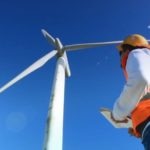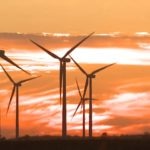Fair winds ahead: Wind energy
Wind has garnered a reputation for being not only an environmentally-friendly, but also a wallet-friendly alternative to produce electricity at a utility-scale level. This is in sharp contrast to the U.S. debut of large wind farms in 1980, which were primarily in response to environmental concerns and emissions reductions standards. Moreover, estimates on the cost of producing electricity with wind energy have been trending downward, making wind energy competitive with conventional energy sources, even after taking into account both government incentives and the historically low prices of natural gas and coal.

A large share of the drop in generation costs reflects less expensive turbines, which are the most important component of a wind energy system. In fact, prices of turbines have gone down 30 percent since their peak in 2008-2009. The turbines are getting bigger, better and cheaper, which portends well for the viability of wind energy.
Although total installed capacity for wind continues to lag behind coal and natural gas, the declining costs of wind energy have led to incremental increases in wind capacity. In 2015 alone, the U.S. installed 8.6 GW of wind generation capacity—more than in 2013 and 2014 combined, and more electric generation capacity than any other source from 2014-2015. As a result, wind energy was responsible for generating 4.7% of total U.S. electricity in 2015 (74.5 GW), up from 0.2% in 2001.

One vital step to achieving a higher share of wind and other renewables in U.S. energy mix is the Clean Power Plan
Despite this rapid growth, challenges lie ahead. One vital step to achieving a higher share of wind and other renewables in U.S. energy mix is the Clean Power Plan (CPP), which sets strong and achievable standards for cutting carbon dioxide emissions from power plants and creates customized goals for states to meet these standards. However, its future is uncertain as the CPP was challenged in court and is currently pending a decision later this year. Another source of uncertainty is the development of storage capacity given that non-dispatchable energy technologies -generating plants that cannot be turned on or off, or cannot adjust their power output accordingly to an order- like wind and solar, need to store output surpluses in order to avoid losing money. Significant amount of resources need to be spent on R&D in order to accelerate innovation in battery technologies.
Wind and other renewables will succeed not only because they have become more competitive alternatives, but also because they are compatible with changes in consumer preferences.
Despite these big challenges, in the long-run, wind and other renewables will succeed not only because they have become more competitive alternatives, but also because they are compatible with changes in consumer preferences. Younger Americans are pushing the transformation toward a greener economy and businesses are responding by using renewable energy to deliver goods and services and reduce their carbon footprints. Increasingly, sovereign-wealth funds, pension funds and university endowments are being pressured by their stakeholders to move away from fossil fuels.
Globally, the future of wind and other renewable energy will ultimately be determined by economic development, environmental concerns and population growth, mainly in the emerging markets. Today, around 1.1 billion people (half of them located in Sub-Saharan Africa) still lack access to electricity. By 2050, global population is expected to reach 9 billion, while sustained economic growth in emerging economies promises to bring hundreds of millions of individuals out of poverty and into the middle class, with a corresponding increase in the demand for transportation, housing and other goods. In this scenario, global energy needs will become massive, requiring an “all of the above approach” in terms of resources. Wind and other renewables have very strong potential in this new environment. This is also true for banks that will be providing the finance needed to make wind energy a common source to power our lives in the 21st century.
Follow BBVA Research U.S.A on Twitter at @bbvaresearchusa.
Any statement or opinion of a BBVA Compass economist is that economist’s own statement or opinion and does not represent a statement or prediction by BBVA Compass, its parent companies or management.